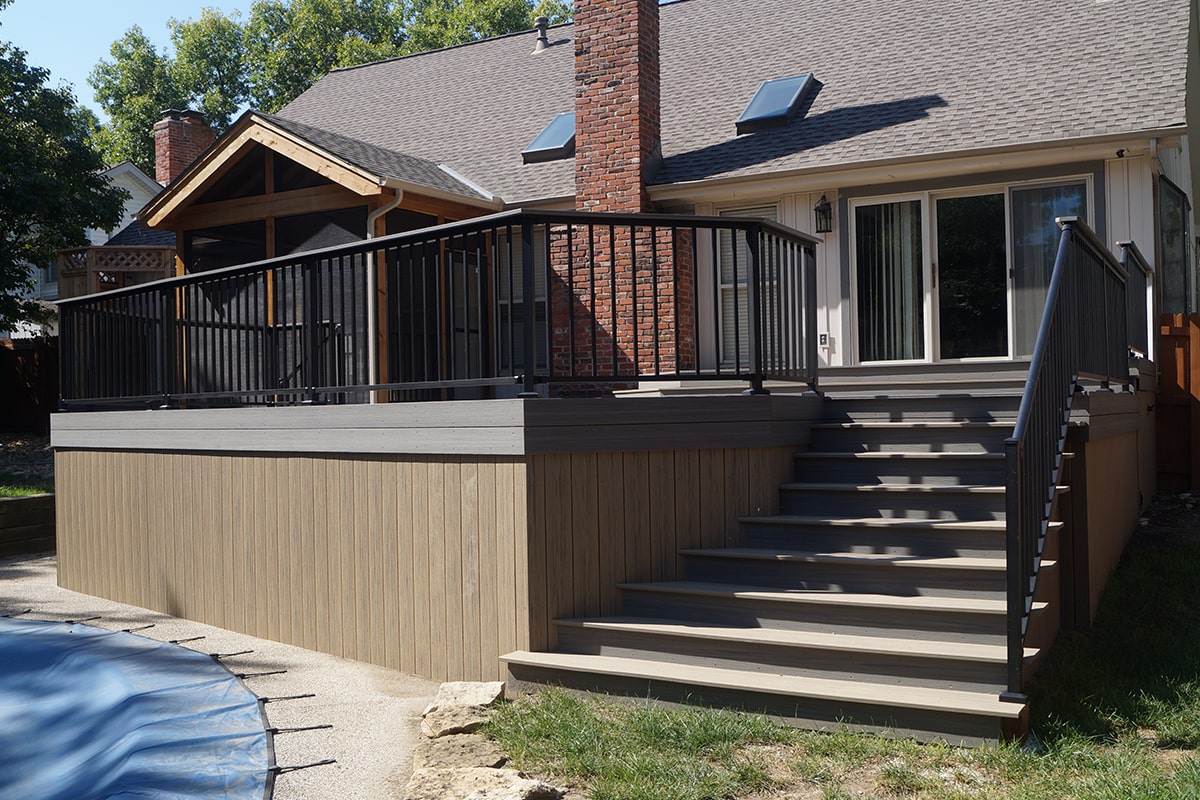Open areas under a deck often collect debris, invite pests, and trap moisture that can damage framing over time. Adding proper deck skirting closes off that space to protect the structure and improve its appearance. It also helps maintain ventilation and allows easy access for inspections or storage. With the right materials and design, it offers long-lasting protection at a reasonable cost.
What Deck Skirting Does for Your Home
Deck skirting serves more than one purpose. It keeps pests away, shields framing from rain splash, and creates visual continuity between the house and deck. For elevated decks, it also hides structural posts and provides privacy for storage areas.
Benefits of adding deck skirting include:
- Reduced risk of rot and moisture buildup
- Better protection from animals or insects
- Improved overall appearance and resale value
- Options for under-deck storage or enclosed space
Key Takeaway: A well-built skirting system balances airflow, durability, and design. If airflow is blocked, moisture can linger and damage framing over time.
Most Affordable Deck Skirting Options
Homeowners can choose from many inexpensive deck skirting materials depending on the style and maintenance level they prefer. Below are several budget-friendly ideas arranged from the lowest to the highest cost options.
1. Pressure-Treated Lumber
A common and reliable choice, pressure-treated boards are easy to find and simple to install vertically or horizontally. They resist decay but need sealing or staining every few years.
2. Lattice Panels
Vinyl or wood lattice panels are among the most affordable choices. They allow air to circulate while blocking direct view under the deck.
3. Slat Fencing
Slats made from cedar or treated pine can be arranged for privacy or pattern. This design is popular for modern decks.
4. PVC or Vinyl Panels
PVC skirting costs slightly more but never rots or warps. It also pairs well with composite decking.
5. Composite Skirting
Composite deck skirting creates a clean, uniform appearance. Although more expensive upfront, it requires no sanding or staining and lasts decades.
6. Landscape Edging or Plant Lines
Plants can act as natural skirting. Combine small shrubs, stone borders, or raised garden beds to hide the deck’s base.
Pro Tip: Combine materials for a designer look. For example, mix lattice with trim boards or surround PVC panels with wood framing for contrast.
Design Ideas That Look Expensive but Stay Affordable
Homeowners often overlook the design impact of deck skirting. A few creative layout choices can make even low-cost materials appear premium.
Modern Horizontal Slats
Use even spacing between boards for a clean, linear finish that feels high-end.
Mixed Materials
Blend wood with stone veneer or composite trim for a richer texture without significantly increasing cost.
Stair Wrap Designs
Extending skirting along stairs creates visual continuity and protects risers from the weather.
DIY or Professional Installation
Many skirting projects can be handled by a skilled DIYer, but larger decks or composite materials may require professional installation.
DIY Considerations:
- Use corrosion-resistant fasteners
- Include ventilation gaps
- Ensure panels are removable for access under the deck
Professional Advantages:
- Precise cuts and code-compliant installation
- Long-term performance and warranty coverage
Need expert help with deck skirting? Contact DW Elite Decks for a free consultation and custom quote.
How to Choose the Right Material for Your Deck
Choosing the right skirting depends on your deck’s height, exposure, and style preferences.
Pressure-Treated Lumber
- Lowest initial cost
- Matches wood-framed decks
- Requires sealing every few years
Composite or PVC Options
- Matches composite decking colors
- Virtually maintenance-free
- Ideal for humid or shaded areas
Masonry-Inspired Skirting
- Stone or brick veneer improves durability
- Adds value and permanence
- Best for decks attached to masonry homes
Key Factors to Consider Before Installing Deck Skirting
Before selecting materials, review the site and framing conditions.
- Ventilation: Maintain air gaps to prevent trapped moisture
- Drainage: Grade soil away from the structure
- Access: Include removable panels or hinged doors
- Pest Control: Add fine mesh where needed
- Aesthetics: Match house color, trim, or railing design
Practical Planning Tips for Long-Lasting Skirting
- Always use ground-contact-rated lumber for framing
- Avoid direct contact between the kirting and the soil
- Install moisture barriers or gravel beds for better drainage
- Use trim boards to cover seams for a polished finish
Key Takeaway: The lowest-cost option is not always the most economical long-term. Materials that resist rot and require less maintenance provide better value over time.
Final Thoughts on Cost-Effective Deck Skirting
Inexpensive deck skirting does more than hide posts. It adds protection, defines the deck’s appearance, and can even extend usable space. Whether you choose lattice, wood, or composite, careful planning ensures your investment lasts.
DW Elite Decks helps homeowners across Kansas City design and build decks that look great and perform for years. Contact our team today to schedule your consultation and explore your best deck skirting options.







